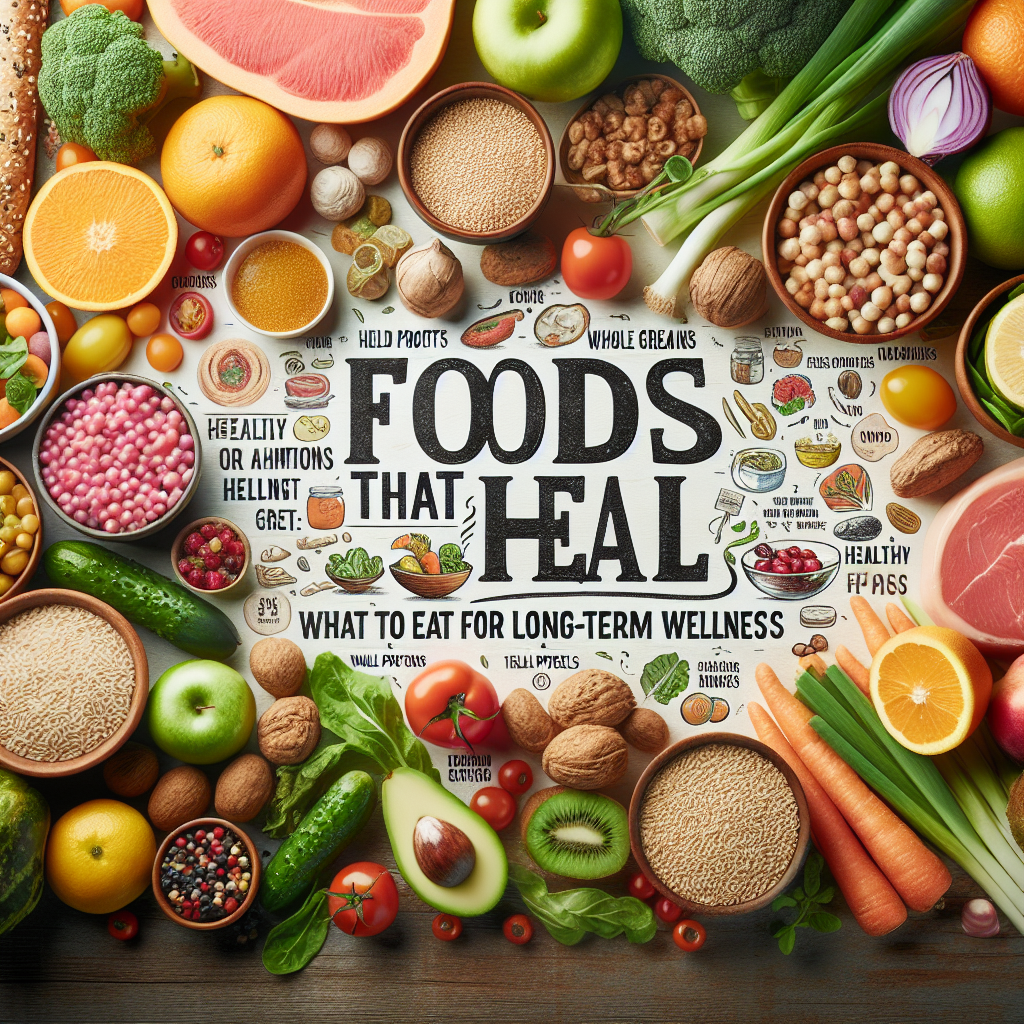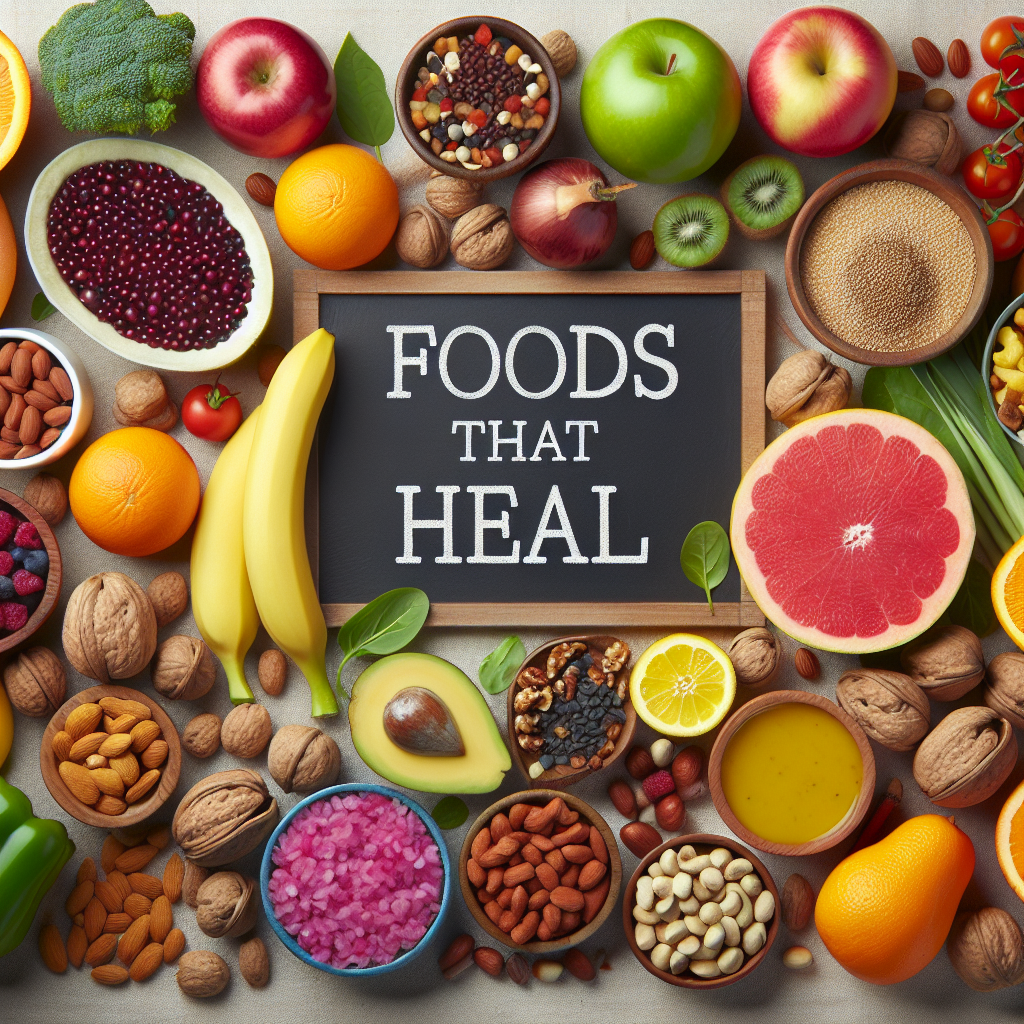Foods That Heal: What to Eat for Long-Term Wellness

Discover the power of Foods That Heal and learn what to eat for long-term wellness. Start your journey towards a healthier lifestyle today. Click here to find out more.
Incorporating Healing Foods: A Guide to Nutritional Wellness
The pursuit of long-term wellness is a journey that begins with the choices we make in our daily lives. One of the most significant choices we make is what we choose to eat. The foods we consume can either contribute to our health or detract from it. This is where the concept of healing foods comes into play. Healing foods are nutrient-dense foods that provide numerous health benefits, including boosting the immune system, reducing inflammation, and promoting overall wellness.
Incorporating healing foods into our diet is a proactive approach to health that can lead to long-term wellness. It’s not about following a restrictive diet or eliminating certain food groups. Instead, it’s about making conscious choices to include foods that nourish and heal our bodies.
Fruits and vegetables are the cornerstone of a healing diet. They are packed with vitamins, minerals, and antioxidants that protect our cells from damage. Leafy greens like spinach and kale, for instance, are rich in iron and calcium, which are essential for blood production and bone health, respectively. Berries, on the other hand, are loaded with antioxidants that fight off harmful free radicals in the body.
Whole grains are another essential component of a healing diet. Unlike refined grains, whole grains retain all parts of the grain — the bran, germ, and endosperm. Foods made from these grains are high in fiber, which aids in digestion and helps control blood sugar levels. Examples of whole grains include brown rice, oatmeal, and whole wheat bread.
Protein is also crucial for healing and repair. It’s not just about meat; plant-based proteins like lentils, chickpeas, and tofu are excellent sources of protein and are also high in fiber and low in fat. Fish, particularly fatty fish like salmon and mackerel, are rich in omega-3 fatty acids, which are known for their anti-inflammatory properties.
Healthy fats are another key element of a healing diet. Avocados, nuts, and seeds are excellent sources of monounsaturated fats, which can help reduce bad cholesterol levels and provide nutrients that are essential for brain function. Olive oil and fatty fish are also good sources of healthy fats.
Lastly, hydration cannot be overlooked when discussing healing foods. Water plays a vital role in nearly every bodily function, including digestion, nutrient absorption, and waste elimination. Staying hydrated helps maintain these functions and promotes overall health.
Incorporating healing foods into your diet doesn’t have to be a daunting task. Start by making small changes, like adding more fruits and vegetables to your meals, swapping refined grains for whole grains, and choosing healthy fats over unhealthy ones. Remember, it’s not about perfection, but progress.
It’s also important to note that while diet plays a significant role in health, it’s just one piece of the wellness puzzle. Regular physical activity, adequate sleep, stress management, and regular medical check-ups are also crucial for long-term wellness.
In conclusion, the foods we eat can significantly impact our health. By choosing nutrient-dense, healing foods, we can nourish our bodies, promote healing, and pave the way for long-term wellness. It’s a journey worth embarking on, for the rewards are not just a healthier body, but a better quality of life.
The Power of Food: Essential Eats for Long-Term Health

The power of food is undeniable. It fuels our bodies, nourishes our cells, and can even have a profound impact on our overall health and wellness. The concept of ‘food as medicine’ is not new. It has been a fundamental belief in many cultures for centuries, and modern science is now catching up, providing evidence to support this ancient wisdom. This article will explore the essential eats for long-term health, highlighting the foods that heal and promote wellness.
Firstly, let’s delve into the world of fruits and vegetables. These are nature’s multivitamins, packed with essential nutrients, antioxidants, and dietary fiber. They are low in calories but high in vitamins and minerals, making them an excellent choice for maintaining a healthy weight and preventing chronic diseases. For instance, berries are rich in antioxidants that protect against cellular damage, while leafy greens like spinach and kale are loaded with vitamins A, C, and K, which support immune function, bone health, and blood clotting.
Next on our list are whole grains. Unlike refined grains, whole grains retain all parts of the grain — the bran, germ, and endosperm. Foods made from these grains are rich in fiber, helping to regulate the digestive system and reduce the risk of heart disease and diabetes. Examples of whole grains include brown rice, oatmeal, and whole wheat bread.
Protein is another essential component of a health-promoting diet. It’s vital for building and repairing tissues, making hormones and enzymes, and supporting immune function. While animal-based proteins like lean meats, poultry, and fish are common choices, plant-based proteins such as lentils, chickpeas, and tofu are excellent alternatives that also offer a host of other health benefits.
Healthy fats are also crucial for long-term wellness. They are necessary for brain function, hormone production, and the absorption of certain vitamins. Foods like avocados, nuts, seeds, and fatty fish like salmon are rich in these beneficial fats. They contain omega-3 fatty acids, which have been shown to reduce inflammation and lower the risk of heart disease.
Lastly, let’s not forget about herbs and spices. These culinary additions do more than just enhance the flavor of our meals. They also boast a range of health benefits. For example, turmeric contains curcumin, a compound with potent anti-inflammatory and antioxidant properties, while garlic has been shown to support heart health and boost the immune system.
In conclusion, the power of food extends far beyond mere sustenance. By incorporating a variety of fruits and vegetables, whole grains, proteins, healthy fats, and herbs and spices into our diets, we can harness this power to promote long-term health and wellness. However, it’s important to remember that no single food or food group can provide all the nutrients we need. A balanced, varied diet, coupled with regular physical activity, is the key to maintaining good health. So, let’s embrace the concept of ‘food as medicine’ and make conscious choices that nourish our bodies and support our well-being. After all, we truly are what we eat.
Nourishing Your Body: Foods That Promote Healing and Wellness
The pursuit of long-term wellness is a journey that begins with the choices we make about what we put into our bodies. The foods we consume play a pivotal role in our overall health, and certain foods have been found to promote healing and wellness. These foods, often referred to as “healing foods,” are rich in essential nutrients that our bodies need to function optimally and to ward off disease.
The concept of food as medicine is not new. For centuries, traditional medicine systems around the world have recognized the healing properties of certain foods. Today, modern science is catching up, with numerous studies confirming the health benefits of a diet rich in fruits, vegetables, whole grains, lean proteins, and healthy fats.
Fruits and vegetables are a cornerstone of a healing diet. They are packed with vitamins, minerals, and antioxidants that help protect the body from disease. For instance, citrus fruits like oranges and grapefruits are high in vitamin C, which boosts the immune system and aids in the body’s healing process. Leafy green vegetables like spinach and kale are rich in vitamins A, C, and K, as well as fiber, iron, and several other key nutrients.
Whole grains, such as brown rice, quinoa, and oats, are another important component of a healing diet. They are a good source of fiber, which aids in digestion and helps to control blood sugar levels. Whole grains also contain B vitamins, which are essential for energy production and the proper functioning of the nervous system.
Lean proteins, including fish, poultry, and legumes, provide the body with essential amino acids that are necessary for tissue repair and regeneration. Fish, in particular, is a good source of omega-3 fatty acids, which have been shown to reduce inflammation in the body.
Healthy fats, such as those found in avocados, nuts, seeds, and olive oil, are also crucial for long-term wellness. These fats help to reduce inflammation, support brain health, and aid in the absorption of fat-soluble vitamins.
In addition to these food groups, certain spices and herbs are known for their healing properties. For example, turmeric contains a compound called curcumin, which has powerful anti-inflammatory and antioxidant effects. Ginger is another healing spice, known for its ability to soothe digestive discomfort and reduce inflammation.
While incorporating these healing foods into your diet is important, it’s equally important to limit or avoid foods that can harm your health. Processed foods, sugary drinks, and foods high in unhealthy fats can contribute to inflammation, weight gain, and a host of other health problems.
In conclusion, nourishing your body with healing foods is a powerful way to promote long-term wellness. By choosing foods that are rich in essential nutrients, you can support your body’s natural healing processes and protect against disease. Remember, the journey to wellness is not about quick fixes or drastic changes, but about making sustainable, healthy choices that you can maintain over the long term. So, the next time you’re planning your meals, consider how you can incorporate more healing foods into your diet. Your body will thank you.